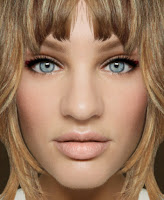The Perfect Face, part 2
Last week, we started our series on the pursuit for the “perfect
face” and discussed symmetry. This week,
we will focus on facial proportions and what people consider to be ideal.
So how do we do this? Obviously, attempting to determine an
ideal shape and size for the amazingly complex structure of the face is a
loaded topic. We are trying to take something that, in my opinion, is truly
artistic and abstract, and quantify it into something that can be measured. At
least one doctor, however, has attempted to take on this very subject.
Dr. Julian De Silva at the Centre for Advanced Facial
Cosmetic & Plastic Surgery in London designed a study that made an attempt
to describe the perfect face. For this study, he used the number Phi.
The number Phi (Φ) equals 1.618 and is considered the “Golden
Ratio.” This number was first defined by
Euclid in around 300 BC, but it’s origins can be documented as far back as
around 450 BC. The Golden Ratio has been observed in nature, including plants,
insects, humans, and even the human heartbeat. Many mathematicians consider it
to be the “secret of beauty.” Finding
the Golden Ratio in nature made it possible to believe that a single number
could help explain the beauty found in our natural environment.
Taking this concept, Dr. De Silva, created a computerized
facial mapping program to create facial proportions based on the Golden
Ratio. He then applied the program to
famous celebrity faces to find the best examples of “the perfect face” based on
his calculations. After searching across
Hollywood to find the face that most closely fits the ideal proportions of the
Golden Ratio, the winner is:
Amber Heard
Amber’s face matched the ideal proportions at 91.8%. So if you agree with Dr. DeSilva’s methodology
to map the perfect face, Amber’s is the closest real-life example (at least in
terms of celebrities’ faces). Still, 91.8% leaves some room for improvement
when it comes to perfection (no offense to Ms. Heard).
To take it one step further, Dr. DeSilva then created ideal
proportions of specific facial
features with his computer mapping program. Again, he compared his maps to faces
of celebrities. For those with the ideal features, results are in:
Best Eyes – Scarlett Johansson (95.9%)
Best Nose – Amber Heard (99.7%)
Best Lips – Emily Ratajkowski (96.7%)
Best Forehead – Kate Moss (98.8)
Best Eyebrows – Kim Kardashian (94.8%)
Best Chin – Amber Heard (99.6%)
Best Facial Shape – Rhianna (91%)
Now, if we take each of those facial features from each of
those celebrities, combine them, and create a new “ideal” face, we end up with:
Looks weird, creepy, crazy…right? So why, if we take all of the ideal features
and put them together, do we not get an ideal face? Why is Amber’s face so obviously more
beautiful than the one above?
Breaking down the face into individual parts without
considering the face as a whole can be difficult and misleading. The nose that looks
beautiful on you will most likely not work for the next person. In that sense
we need to consider the harmony of
the face. Harmony means that there is a
balance between each individual part that creates an overall facial type and
individual, unique face. This also is an argument against the Golden Ratio as
an accurate measurement of beauty. It
does not take different facial types and harmony into account.
But perhaps beauty cannot truly be measured. Perhaps there is no such thing as ideal proportions
for the human face. Different proportions
work for different types of faces, and that complex topic alone makes the task
of quantifying beauty seemingly impossible.
This is a debate that has existed since the beginning of time and will
continue on for eternity.
To read more about Dr. De Silva and his studies, you can see
him here: http://www.londonfacialplasticsurgery.co.uk/
I will finish this blog with a great quote from Tina Fey:
“Now every girl is
expected to have Caucasian blue eyes, full Spanish lips, a classic button nose,
hairless Asian skin with a California tan, a Jamaican dance hall ass, long
Swedish legs, small Japanese feet, the abs of a lesbian gym owner, the hips of
a nine-year-old boy, the arms of Michelle Obama, and doll tits. The person
closest to actually achieving this look is Kim Kardashian, who, as we know, was
made by Russian scientists to sabotage our athletes.”
In our next segment, we will expand on this topic and
discuss the most requested celebrity facial features by patients to their
surgeons.
Here’s to the beautiful human face,
-Dr. Yamamoto








